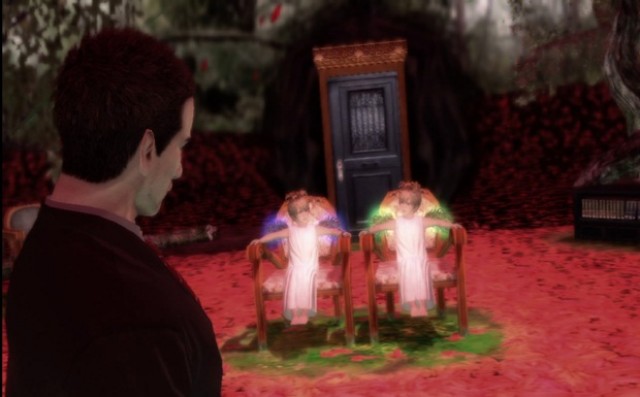During a recent world tour for Deadly Premonition: Director’s Cut, we had a chance to sit down with SWERY himself, to talk about all things Deadly Premonition. This is the first part of the interview, with the second part coming at a later date, as more of a profile.
On with the interview!
GodisaGeek: It’s impossible to categorise Deadly Premonition in terms of game genres (it’s an adventure/open world/horror/role-playing/shooter/mystery game). Also, in the past when you’ve spoken about the game’s influence, you’ve talked about films, TV shows and the American and Canadian landscape. Did this willingness to look outside video games for inspiration result in a more original game?
SWERY: I think so. In order to create something new, we need to get inspiration from other forms of entertainment besides video games. As for the game I created, I can say it is the result of a mixture of inspirations.
GodisaGeek: A word that’s used a lot in games criticism is “cinematic”, applied to games with huge action set-pieces and (often) linear plots. I’d argue that with its focus on conversation, character and the kinds of mundane activities films use to set a scene, Deadly Premonition is actually very cinematic, even though it’s not linear and there aren’t many action scenes. Would you agree with this, and do you think cinema’s influence on games is a good thing?
SWERY: That’s right. Because it’s not as if I was going to create a film, I didn’t create the storyline or characters first. The first thing I started when developing the game was “designing the country town”. That’s why this game is not simply linear. What I created is not a film, but a video game.
GodisaGeek: Here’s a quote from an earlier interview (with The Telegraph’s Tom Hoggins), where you explain something that I think is crucial to Deadly Premonition’s appeal:
“Without incidental elements, you can’t create this dark, fearful side. […] I wanted to make a game in which you inhabit a realist world, solving mysteries that could actually have happened. In this way, the meaningless “incidental” parts of the game are actual indispensable elements.”
Much of Deadly Premonition’s emotional resonance comes from the amount of time you spend on mundane tasks. If you look at games with successful narratives, you realise a lot of them use domestic settings or everyday life to make you care about the outcome of the action, because you want to protect that way of life. What other games do you think have done this well, either in recent years or throughout the history of gaming?
SWERY: I think there’s no game which achieved what Deadly Premonition achieved. So, the answer is “none”.

GodisaGeek: I think we can all agree with that! One thing you’ve said you’d like to do in the Director’s Cut is have York be able to buy a house in Greenvale. Is that just because it would help players identify even more with the town or because it would be a fun gameplay mechanic?
SWERY: This was the idea from the producer, and I thought it was reasonable. Because this game is not a simple mystery game. Of course, the purpose of this game is to solve the mystery but the more important thing is “to feel the life in the country town”. You can enjoy the stay in the country town as York.
GodisaGeek: I really love games where I can dress my character up, so I loved all York’s suits. What was behind the decision to make them such a big part of the reward system in the game. Many of the minigames and side quests have new suits as the reward?
SWERY: This is another way you can “feel the life in the country town”. If you lead the life, you will have to change clothes; it’s a natural thing.
GodisaGeek: York and Zach have lots of conversations about pop culture, particularly movies. Talking about things that exist in the “real world” is quite rare in games, why do you think this is?
SWERY: Because most games force the player to walk along creator’s idea.
GodisaGeek: In this GameSpot interview, you talk about having to tone down some of the violence in the game at the request of the publishers, saying that “the way people are killed” was “too extreme”. While the games industry is understandably more concerned about violence than the film industry is, do you think that this concern is something that compromises game narrative overall?
SWERY: Creators have to get over those restrictions and they end up making a greater game as a result, so I disagree.

GodisaGeek: Deadly Premonition had quite a troubled journey through development, but despite that, and the lack of resources, the game is unique, addictive and very coherent. Do you think limitations breed creativity?
SWERY: Again, creators must get over those matters and make greater game than before.
GodisaGeek: Reception to Emily has been overwhelmingly positive at a time when the industry is still struggling with the way it depicts women. Why do you think players like her so much?
SWERY: I think she is likely to be found in the real world. She is strong, pure… and not good at cooking.
GodisaGeek: Just about every time you’re mentioned online, it’s in relationship to Deadly Premonition. Are you worried about being defined by it, or your other games being ignored?
SWERY: I don’t care at all!
Thanks to SWERY and Rising Star Games for taking the time to answer our questions about a game that’s still fascinating. We can’t wait for the Director’s Cut!





